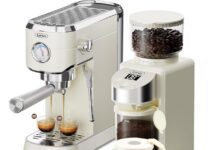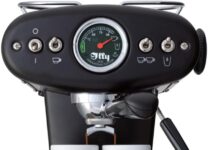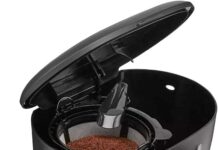Ever wondered how to keep those pesky coffee grounds out of your beloved Bialetti brew? Look no further! In this article, we will unveil a few simple yet effective techniques to help you savor that perfect cup of coffee every time. Say goodbye to the unwanted grit in your morning pick-me-up, as we share our top tips for a clean and smooth Bialetti coffee experience.
Choosing the Right Coffee Grind
Understanding Coffee Grind Sizes
When it comes to making a perfect cup of coffee with a Bialetti Moka pot, choosing the right grind size is crucial. Coffee grind sizes play a significant role in determining the final flavor and strength of your brew. Understanding the differences between various grind sizes will help you make an informed decision for your Bialetti coffee.
Coffee grind sizes range from coarse to fine, and each size is suitable for different brewing methods. Coarse grinds, like those used for French press, have larger particles, while finer grinds, like espresso, have smaller particles. For the Bialetti Moka pot, a grind size in between these extremes is recommended. A medium-fine grind will allow for optimal extraction of flavors while avoiding any clogging issues.
Selecting the Right Grind Size for Bialetti
To achieve the best results with your Bialetti Moka pot, it is essential to select the right grind size. A medium-fine grind, similar to the texture of granulated sugar, is ideal for this brewing method. This grind size allows the water to extract flavors from the coffee grounds while ensuring a smooth flow through the filter basket.
Using a grind size that is too coarse may result in weak and under-extracted coffee, while a grind that is too fine can lead to bitter and over-extracted flavors. Finding the right balance will result in a rich, full-bodied, and perfectly balanced cup of coffee.
Using Consistently Ground Coffee
Consistency is key when it comes to grinding coffee for your Bialetti Moka pot. Unevenly ground coffee can lead to inconsistent extraction, resulting in a brew that lacks depth and flavor. Investing in a quality burr grinder is highly recommended for achieving a consistently ground coffee.
Grinding Coffee Beans Properly
Investing in a Burr Grinder
For the best coffee grinding experience, it is worth investing in a burr grinder. Burr grinders provide a more precise and consistent grind compared to blade grinders. They crush the coffee beans between two burrs, which allows for a more even grind size distribution.
A burr grinder will ensure that all the coffee particles are of the same size, avoiding any under-extracted or over-extracted flavors. It provides the control and versatility needed to achieve the perfect grind size for your Bialetti Moka pot.
Avoiding Blade Grinders
Blade grinders, on the other hand, should be avoided when grinding coffee for your Bialetti Moka pot. Blade grinders chop the coffee beans using spinning blades, resulting in an uneven grind. This inconsistency can lead to over-extraction of finer particles and under-extraction of larger particles.
The lack of control and precision in blade grinders may result in a brew that is either too weak or too bitter. To achieve the best possible flavor and consistency, it is recommended to opt for a burr grinder instead.
The Optimal Grind Consistency
To achieve the optimal flavor and consistency when brewing with a Bialetti Moka pot, aim for a grind consistency similar to table salt. This medium-fine grind allows for proper extraction while preventing any clogging or slow brewing issues. Consistently ground coffee will ensure that each batch of coffee you brew with your Moka pot is of the highest quality.
Using the Correct Amount of Coffee
Determining the Ideal Coffee-to-Water Ratio
One of the keys to a delicious cup of coffee with a Bialetti Moka pot is using the correct amount of coffee relative to the amount of water. The ideal coffee-to-water ratio depends on personal preference, but a general guideline is to use around 1 to 1.5 tablespoons of coffee for every six ounces of water.
Experimenting with different ratios will allow you to find the perfect balance that suits your taste buds. Remember that using too much coffee may result in a strong and overpowering brew, while using too little coffee may produce a weak and lackluster cup.
Avoiding Overfilling the Filter Basket
When filling the filter basket of your Bialetti Moka pot, it is crucial not to overfill it with coffee grounds. Overfilling can prevent proper water flow through the coffee bed, leading to a slow and uneven extraction. This can result in a brew that is both weak and bitter.
Fill the filter basket just below the rim, ensuring there is enough space for water to flow through the coffee grounds evenly. This will help you achieve a well-balanced and flavorful cup of coffee with your Bialetti Moka pot.
Measuring Coffee Accurately
To ensure consistency in your brewing process, it is essential to measure your coffee accurately. Using a scale to weigh your coffee grounds will give you the most precise measurement. However, if you don’t have a scale, using a tablespoon as a measurement tool is a suitable alternative.
When using a tablespoon, aim for a level scoop of coffee grounds for each tablespoon. This will help you maintain a consistent coffee-to-water ratio and achieve the desired strength and flavor in your Bialetti Moka pot.
Prepping the Moka Pot
Cleaning and Maintaining Your Bialetti
Before using your Bialetti Moka pot, it is essential to clean and maintain it properly. Regular cleaning helps remove any coffee residue or oils that may affect the flavor of your brew. Disassemble the Moka pot, rinse it with warm water, and use a mild detergent to clean the different components thoroughly.
Avoid using harsh abrasives or brushes that may scratch the surfaces of your Moka pot. Ensure all the parts are dry before reassembling the pot for brewing. Proper cleaning and maintenance will prolong the lifespan of your Bialetti Moka pot and ensure consistently delicious coffee.
Checking for Damaged or Worn Parts
Inspect your Bialetti Moka pot for any damaged or worn parts before each use. This ensures that all components are in good condition and functioning correctly. Look for any cracks, dents, or loose fittings that may affect the brewing process or safety.
If you notice any damaged parts, it is important to replace them immediately. Using a compromised Moka pot can lead to issues such as leaks or improper extraction, which can negatively impact the quality of your coffee.
Properly Assembling the Moka Pot
Proper assembly is vital for the successful brewing of coffee with your Bialetti Moka pot. Start by filling the lower chamber with freshly boiled water up to just below the pressure valve. Then, insert the filter basket and add the desired amount of ground coffee.
Ensure that the filter basket is securely in place before screwing on the upper chamber. Use a cloth or oven mitt to hold the Moka pot as it may get hot during the brewing process. A properly assembled Bialetti Moka pot will result in a smooth and hassle-free brewing experience.
Avoiding Common Brewing Mistakes
Applying Gentle and Even Heat
When brewing coffee with a Bialetti Moka pot, it is important to apply gentle and even heat. The Moka pot is designed to work best with low to medium heat to ensure a smooth and consistent extraction process. Avoid using high heat settings, as this can lead to a rushed extraction and potentially burnt flavors.
Place your Moka pot on a stovetop burner set to medium heat and allow it to brew slowly. The gentle heat will coax out the flavors from the coffee grounds, resulting in a well-balanced and aromatic cup of coffee.
Avoiding High Heat Settings
Using high heat settings is a common mistake many people make when brewing coffee with a Bialetti Moka pot. The high heat can cause the water to boil too quickly, resulting in coffee that is over-extracted and bitter.
To avoid this, it is recommended to use medium heat and allow the brewing process to take its time. This will allow for a more controlled extraction and a better-tasting cup of coffee.
Removing the Moka Pot from Heat at the Right Time
Timing is crucial when brewing coffee with a Bialetti Moka pot. It is important to remove the Moka pot from the heat source at the right time to avoid over-extraction or burnt flavors.
As soon as you hear a bubbling or gurgling sound, indicating that the water has passed through the coffee grounds and into the upper chamber, it’s time to remove the pot from the heat. This will prevent any further extraction and ensure a flavorful and well-balanced cup of coffee.
Avoiding Agitation During Brewing
Reducing Stirring or Agitating the Coffee Bed
While brewing with a Bialetti Moka pot, it is important to avoid stirring or agitating the coffee bed during the brewing process. Stirring can disrupt the extraction process and result in an uneven extraction, leading to a brew that lacks complexity and consistency.
Instead, allow the water to naturally flow through the coffee grounds without any interference. This will ensure a more even extraction and a better cup of coffee.
Avoiding Excessive Movement of the Moka Pot
During the brewing process, it is crucial to minimize any unnecessary movement of the Moka pot. Excessive shaking or tilting can cause water to spill over, resulting in a messy and uneven extraction.
To maintain a stable brewing environment, it is recommended to handle the Moka pot with care and avoid any unnecessary movements. This will help maintain the integrity of the brewing process and ensure a consistently flavorful cup of coffee.
Maintaining Steady Brewing Conditions
Consistency is key when brewing with a Bialetti Moka pot. To achieve the best results, it is important to maintain steady brewing conditions throughout the process.
Ensure that the heat source is consistent and not fluctuating excessively. Avoid removing the Moka pot from the heat and then placing it back on repeatedly. Fluctuating heat can lead to an inconsistent extraction and affect the overall flavor of your coffee.
Using a Fine Mesh Filter
Replacing the Standard Filter with a Fine Mesh Option
For those looking for a cleaner and more sediment-free cup of coffee, replacing the standard filter of the Bialetti Moka pot with a fine mesh option can be beneficial. The fine mesh filter provides an extra barrier, preventing any coffee grounds or sediments from ending up in your cup.
Replacing the filter is a simple process. Look for a fine mesh filter that is compatible with your Bialetti Moka pot and replace the existing filter with the new one. This will give you a smoother and more refined cup of coffee.
Benefits of Using a Fine Mesh Filter
Using a fine mesh filter offers several benefits when brewing with a Bialetti Moka pot. Firstly, it eliminates any grounds or sediments that may find their way into your cup, resulting in a cleaner and more visually appealing brew. Additionally, it allows for a smoother and more even extraction, enhancing the overall flavor and aroma of the coffee.
Using a fine mesh filter is a personal choice and depends on your preferences. While it may require an additional purchase, it can greatly improve the quality of your brewed coffee.
Ensuring Proper Fit and Avoiding Gaps
When using a fine mesh filter with your Bialetti Moka pot, it is important to ensure a proper fit and avoid any gaps or misalignments. This will prevent any water or coffee from bypassing the filter and ending up in your cup.
Before assembling the Moka pot, double-check that the fine mesh filter is securely in place and does not move when adding coffee grounds or water. Proper fitting will guarantee a smooth and sediment-free extraction process.
Exploring Alternative Brewing Methods
Trying the Paper Filter Trick
If you find that using a mesh filter still allows some sediments to pass through, a popular trick is to add a paper filter in addition to the fine mesh filter. This combination helps achieve an even cleaner brew, completely free of any grounds or particles.
Simply place a paper filter on top of the fine mesh filter before adding the coffee grounds. The paper filter acts as an additional barrier, catching any smaller particles and ensuring a sediment-free cup of coffee.
Using a French Press for Pre-Straining
Another alternative brewing method that can help in achieving a cleaner brew with your Bialetti Moka pot is using a French press for pre-straining. This involves pouring the brewed coffee from the Moka pot into a French press lined with a mesh filter or a paper filter.
Pouring the brewed coffee through the French press will strain out any remaining sediments or grounds, resulting in a cleaner and smoother cup of coffee. This method is particularly useful for those who prefer a highly clarified and sediment-free brew.
Experimenting with Other Filter Options
For those seeking even more refined brewing techniques, there are various other filter options to explore. Different materials and designs can offer unique filtering properties, resulting in customized brewing experiences.
Options such as cloth filters, metal mesh filters, or even ceramic filters can provide alternative flavor profiles and unique brew characteristics. Experimenting with different filter options is a fun and exciting way to discover new nuances in your Bialetti Moka pot brews.
Optimizing Water Temperature
Determining the Ideal Water Temperature
Water temperature plays a crucial role in brewing the perfect cup of coffee with a Bialetti Moka pot. The ideal water temperature for this brewing method is around 195 to 205 degrees Fahrenheit (90 to 96 degrees Celsius).
Water at this temperature range helps achieve a proper extraction of flavors from the coffee grounds without scorching them. Using water that is too cold will result in an under-extracted cup, while water that is too hot can lead to over-extraction and bitterness.
Avoiding Boiling Temperature
While it is important to heat the water to the ideal temperature for brewing, it is crucial to avoid boiling the water. Boiling water can lead to over-extraction and a brew that is both bitter and unbalanced.
To prevent boiling, remove the water from the heat source just before it reaches its rolling boil point. This will ensure that the water is at the optimal temperature to extract the rich flavors from the coffee grounds, resulting in a delicious and well-balanced cup of coffee.
Preheating Water and Using Preheated Water
To optimize the brewing process, preheating the water and using preheated water in your Bialetti Moka pot can be beneficial. Preheating the water helps maintain a stable brewing temperature throughout the process.
To preheat the water, simply boil the desired amount of water in a kettle or saucepan before pouring it into the Moka pot. This ensures that the water is at the proper temperature from the start, allowing for a consistent extraction and flavorful coffee.
Additionally, preheating the Moka pot itself by rinsing it with hot water can help avoid any temperature fluctuations during brewing. Preheating the pot will prevent heat loss and further contribute to an optimal brewing experience.
Fine-tuning Brewing Techniques
Adjusting Heat and Brew Time
Fine-tuning your brewing techniques can significantly impact the flavor and quality of your Bialetti Moka pot coffee. Two key aspects to consider when fine-tuning are the heat level and the brew time.
Adjusting the heat level can help you achieve the desired strength and extraction profile. Experiment with slightly lower or higher heat settings to find the sweet spot that suits your taste preferences. The goal is to achieve a slow and steady extraction without rushing the process.
Similarly, the brew time can be adjusted to fine-tune your coffee’s flavor profile. You can try slightly shorter or longer brew times to see how it affects the overall taste. Remember to keep notes on each adjustment to find the perfect combination that produces your ideal cup of coffee.
Practicing Patience During the Brewing Process
One of the keys to brewing great coffee with a Bialetti Moka pot is practicing patience. Rushing the process can result in under-extracted flavors and a less enjoyable cup of coffee. It is important to allow sufficient time for the water to extract the flavors from the coffee grounds properly.
Resist the temptation to turn up the heat or remove the Moka pot prematurely. Instead, trust in the time-tested method of the Moka pot and let it work its magic. Practicing patience will reward you with a rich and flavorful cup of coffee.
Adapting to Personal Preferences
Ultimately, the art of brewing coffee with a Bialetti Moka pot is about adapting to your personal preferences. Experimentation and tweaking your techniques will help you achieve the perfect cup of coffee that suits your taste buds.
Don’t be afraid to try different coffee beans, grind sizes, water temperatures, and brewing times. Each adjustment will bring you closer to finding the unique brewing method and flavor combination that makes your coffee experience truly enjoyable.
In conclusion, brewing coffee with a Bialetti Moka pot requires attention to detail and a thoughtful approach. From choosing the right grind size to using the correct amount of coffee and optimizing water temperature, each step contributes to the final result. By understanding the brewing process and following these guidelines, you can brew consistently delicious coffee with your Bialetti Moka pot.




































